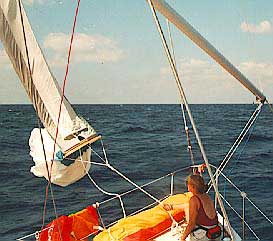
DOWNWIND
SAILS FOR CRUISERS
[This article is by Jim and Sue Corenman] [Comments in [square brackets] are by Kame Richards Some comments on downwind sails: Our observation is that only a few cruisers take the sailing part seriously, and most are content to make lots of compromises for the sake of convenience and not worry about it. Sail area is one such topic, and while most cruisers understand that things are less windy downwind, they don't take the next step and set a larger sail when sailing downwind. But more than convenience, we think fear is the biggest factor, fear that things will get too windy for a large downwind sail, resulting in general chaos and unpleasantness, and jeeze, how do you get that thing down anyway? Sue and I are pretty odd cruisers in that we really enjoy sailing, and look at passages as opportunities to go sailing. We've also done a lot of ocean racing (maybe that's how we got this way), and don't think twice about changing the sail configuration to suit the conditions (that's the biggest reason that we don't have a furler... we can't decide which jib we would want to see all the time).Sailing downwind means less apparent wind, which means that the boat can carry quite a bit more sail area to maintain reasonable boat speed. A bigger jib is one choice, but for most boats a better answer is a larger sail yet, i.e. a spinnaker of some sort. One popular choice is an asymmetric cruising spinnaker, generally tacked to the boat's centerline, either to the headstay or sometimes to a bow pole. This arrangement is great on a broad reach, down to about 130-140 degrees AWA (apparent wind angle), but trying to sail deeper than that causes the spinnaker to collapse in the lee of the main. Being tacked to the centerline, they won't generally wrap, but it is still annoying and ineffective. When running or sailing a very broad reach, an asymmetric spinnaker really wants to be flipped around and poled out into the fresh breeze opposite the main. Few people like to do that, because it means handling a pole. Symmetric spinnakers were born out of racing, but they have a lot to offer as downwind cruising sails. The biggest advantage is that since they are tacked to a spinnaker pole, the tack is moveable, and can be adjusted forward or back, up or down to suit different conditions. This makes symmetric spinnakers very effective even at deep sailing angles, which are all too common. (Murphy's law applied to cruising says that the destination lies either directly upwind or downwind). And symmetric spinnakers are big, substantially bigger than most asymmetrics, which is great for light air sailing (although a large asymmetric is quite effective in light air, because of the reaching angles associated with optimum light-air running). Our conclusion was that if you needed to set a pole anyway to sail a broad reach or a run with an asymmetric cruising spinnaker, why not just set a real spinnaker in the first place and enjoy the increased area and versatility? We have a cruising spinnaker aboard, so this is not just idle thinking, and have sailed with it tacked to the headstay, to the bow fitting, onto a spinnaker pole set low, and poled out to windward. And we always look at it, scratch our heads, and can't figure out why it is supposed to be easier. There are some potential problems with spinnakers that need to be addressed before you can really be comfortable. Getting them set without drama is one, but that is easy enough to do with a sock or snuffer or whatever you want to call it. Getting them down is another matter altogether, and it has been repeatedly demonstrated that a sock can't be pulled down if the sail is still full. And the potential for wrapping a spinnaker around the headstay is real. A few comments on gear:The pole will be used a lot of course, and will carry a lot of load particularly if things get a little goofy. We will of course endeavor to keep the sail under control at all times, but you don't want the pole folding up if that goal is not met. So it needs to be a proper pole, the right length for the boat (usually the boat's "J" measurement, from the mast to the headstay fitting) and of sufficient diameter. Skinny whisker poles and telescoping poles are definitely out. The easiest place to stow a pole is with the inboard end pulled up on an extended mast track, vertically in front of the mast. That will allow it to be deployed on either side of the headstay without having to handle a heavy pole on deck. It needs a proper pole lift from a point as high as practical (for leverage) and a foreguy to the middle of the foredeck and led aft. (Our poles are stowed on deck, but they are carbon, about half the weight of an aluminum pole. If that appeals, talk to Larry Tuttle at Waterat in Santa Cruz; he does carbon poles for a lot of big race boats). We use double sheets and guys, but most folks would be happy with single gear. Use spectra for the afterguys, Dacron for the sheet (unless a single set of gear is used in which case you probably want Spectra). Good shackles are important, Sparcraft's are the best if you can still get them, Gibb and Wichard are OK also. Do not use shackles with pull-pins, e.g. Nicro Fico, as they will shake loose when you least want them to. The blocks for the sheets (and guys if used) should be set forward of where you might set them for racing. Sheet blocks are normally positioned all the way aft, but moving them 5-10' forward (or setting a snatch block) will choke the spinnaker down a bit and make it more stable, as well as preventing the sheet from chafing on the underside of the boom. Moving the afterguy block forward will reduce the upward pull on the pole, making life easier for the end fitting as well as preventing the pole from heading for the sky every time the foreguy is eased. A sock is almost essential for cruising with a spinnaker. There are many kinds of socks, some with their control lines in a separate sleeve, some with external lines. Our favorite is the type with a the lines in a separate sleeve, such as the Pineapple Snuffers or the ATN sock, but most of the others work just fine. Be sure that the sock is long enough to reach within a couple of feet of the clews, as having ten feet of sail hanging out the bottom of the sock is a nuisance. Setting the Spinnaker:We use the Honey/Lindsay method for getting the spinnaker up. (Stan Honey and Sally Lindsay are well-known San Francisco sailors who have won most of the west coast short-handed races at one point or another, including an overall win double-handed in the '96 West Marine Pacific Cup Race to Hawaii). |
|
Step One: Get the pole set up, with the inboard end in the normal position (i.e. about 12% of "I" off the deck), and the outboard end in what we will call the "Set" position, low and inboard from its normal position. The pole jaw should be 5-6' above the deck and 2-3' to windward of the headstay, so that it is a comfortable reach from the bow with one arm wrapped around the headstay. The afterguy is in the pole fitting, with no sail attached yet, and the afterguy, foreguy and pole lift are all snugged up tight to hold the pole firmly in this position. Mark the lines (lift and afterguy) so the pole can be returned to this "Set Position" without fiddling. |
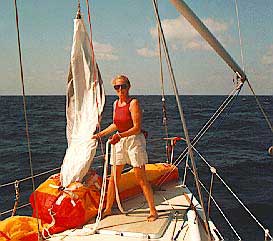 |
Step two: Set the autopilot to an AWA of about 130, tie the sock control lines down to a bow cleat, and hoist the halyard. Yes, the spinnaker clews are not attached to anything yet, that is the key. |
|
Step three: Once the halyard is up, spin the sock around as required to sort out the tack and clew, making sure that the control line is clear on the inside of the sail and not twisted at the top. Pull one corner (doesn't matter which, but call it the "tack") around the headstay and clip it into the afterguy shackle at end of the pole, and clip the sheet onto the other corner (the clew). Take a moment to check that the spinnaker, sheets (and lazy guys if rigged) are outside the headstay, shrouds and lifelines. |
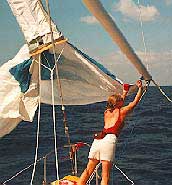 |
Step four: Pull the sheet in a bit to start the sail filling, and raise the sock. |
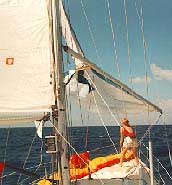 |
| [At this point the sock is fully hoisted. Notice that the spinnaker is fairly choked with the pole tip still low, in the "set" position.] | 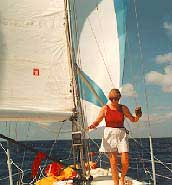 |
| Once the sail is flying, move the pole tip up and aft by easing the foreguy and taking up the lift. The afterguy
will be close enough for now. |
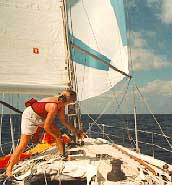 |
That's it for the hoist, set the auto pilot where you want it, and fix up the pole height and sheet trim. We use the autopilot's apparent wind mode exclusively when sailing downwind, to maintain proper sail trim and (perhaps more importantly) to avoid accidental jibes. Sailing much below 150 AWA by autopilot is a bit dicey, and the boat is happier on a bit of a reach no matter what the sail combination is. [This photograph, and the preceding two. are looking nearly straight down the centerline of the boat. See how the spinnaker is exposed as the pole is lifted and squared aft. With the spinnaker pole properly trimmed, notice how much of the sail is to weather of the centerline. This is why the symmetric spinnaker gives better performance sailing runs.] When we are sailing deep wind angles (i.e. 140-150 degrees AWA), we often set a spinnaker net, particularly at night. Nets are old- fashioned but work just fine, and eliminate the worry of a wrap. Ours has a "luff" and "leach" of 3/8" yellow polypropylene rope, with five straps of sail-tie webbing from luff to leach in the top half of the foretriangle. Cheap and simple, and works like a charm. |
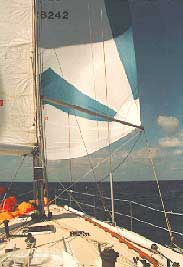 |
Dousing:
Getting a spinnaker up is fine, but what about getting it down? And especially when the wind comes up? The extra sail area is great as long as the boat keeps sailing downwind, and it is important to douse the spinnaker well before boat control becomes an issue. If the boat stops going downwind (as in a round up), things will get windy in a hurry, and that is bad when you have a lot of sail set. Our usual drill for a take-down is to return the pole to the "set position", walk forward, and trip the guy shackle with a fid. This releases the tack, and the sail will flop around behind the main until the sock line is pulled down. Pulling in the lazy guy or the sheet will help keep the sail behind the main until it is socked. In lighter winds, simply easing the pole near the headstay and sailing low is enough to collapse the spinnaker behind the main, and simply pull the sock down when the sail collapses. Once the sail is socked, it is harmless and the halyard can be dropped in a leisurely fashion. And if it gets windy, letting go of the sheet and pulling the pole end down and inboard (to the "set" position or below) will allow the sock to be pulled down from the bow pulpit. The trick, if it is windy, is to let go of one side of the sail and pull the other side relatively straight, i.e. let go of the tack at the end of the pole) and tighten the sheet or lazy guy, or let go of the sheet and lower the tack by dropping the pole end. The only difference is where the sail flops around, either behind the main or out ahead of the forestay. Our preference on "Heart of Gold" is to let go of the tack and take in the lazy guy to bring the spinnaker into the lee of the main. 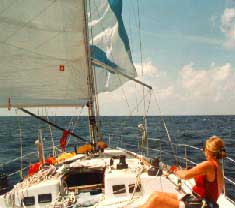 We've got one
more trick to make this easier, in deference to the size of our spinnakers (approximately 2,000 square
feet). We made up a "trip fitting" to release the afterguy shackle from the cockpit. It is a T-shaped
affair that fits through the fid hole of a Sparcraft shackle, a fiberglass crossbar and a wire stem,
led via a microblock to a small 3:1 tackle inside the pole and then back to the cockpit. A solid tug
on the cockpit end of the trip line releases the spinnaker from the pole end, unloading it instantly.
Pull in the lazy guy or sheet, and leisurely wander forward and sock the sail. This system works like
a dream, whether the problem is a squall or a fish. [In the photograph, Sue has just tripped the afterguy
snap shackle while sitting in the cockpit. Another benefit of this tripping mechanism is that the spinnaker
pole is still being held frimly in position by the topping lift, foreguy and afterguy, so the pole will
not be flailing around crashing into things.] We've got one
more trick to make this easier, in deference to the size of our spinnakers (approximately 2,000 square
feet). We made up a "trip fitting" to release the afterguy shackle from the cockpit. It is a T-shaped
affair that fits through the fid hole of a Sparcraft shackle, a fiberglass crossbar and a wire stem,
led via a microblock to a small 3:1 tackle inside the pole and then back to the cockpit. A solid tug
on the cockpit end of the trip line releases the spinnaker from the pole end, unloading it instantly.
Pull in the lazy guy or sheet, and leisurely wander forward and sock the sail. This system works like
a dream, whether the problem is a squall or a fish. [In the photograph, Sue has just tripped the afterguy
snap shackle while sitting in the cockpit. Another benefit of this tripping mechanism is that the spinnaker
pole is still being held frimly in position by the topping lift, foreguy and afterguy, so the pole will
not be flailing around crashing into things.][These two photos show details of how the tripping mechanism is rigged.]
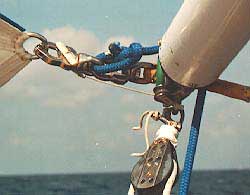 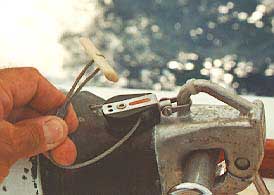 Those are all the tricky bits. There's a lot of basic stuff about spinnaker handling covered in detail in The Pacific Cup Handbook which Sue and I have put together (available from Pineapple Sails or West Marine).
Stan Honey sent us the following list of further suggestions: Jim, Great write-up of shorthanded spinnaker handling in the Pineapple Web Site, and thanks for the credit. The only addition that I would make, is at the beginning of Step Four in the set, just before you start to hoist the sock, reach into the bell and grab a handfull of the foot of the sail, so that as the sock starts to go up it doesn't drag with it the belly of the sail.If the belly of the sail gets dragged up, then the sock gets all constipated when it is about half way up. Whereas if the belly of the sail stays where it belongs, then the sock goes up very easily. As the sock goes up, even though it is a powered ascent, driven by the filling kite, I have found that you should hoist the uphaul as fast as you can to keep the sock clear. As an aside, the sock stays the best organized when you are sailing in windy singlehanded events in which the sheet stays loose and the sock gets manually hoisted all the way to the top before the kite gets sheeted in. This isn't as cool as the powered ascent mode, so Sally and I never do it that way in a doublehanded race. Once the sock is up, I tie the uphaul line quite tight to the lifeline, and then tie the downhaul line loosely to the lifeline a foot or so further aft. This keeps the lines from twisting, and keeps the bell at the masthead out of trouble. To douse at night, you grab the downhaul line, and then untie the uphaul and downhaul knots without ever losing grip of the downhaul line. Even though the lines end up snaking all around your forearms, you know that they are all straight and that all you have to do is to pull the downhaul without ever letting go of it or reaching over another line. |
|
Copyright ©2011 Pineapple Sails
2526 Blanding Avenue
Alameda, CA 94501 USA - directions
(510) 522-2200
